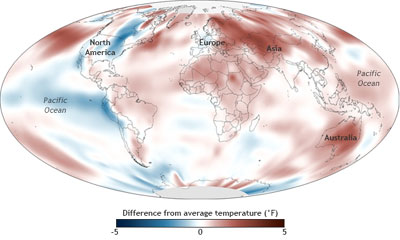Update January 2015: 2014 was the hottest year ever recorded.
—
As the US drills for ever-increasing amounts of oil and gas – now the leading producer in the world! – the earth keeps getting hotter.
Since records began in 1880, this May and June were the hottest ever, reports the National Oceanic and Atmospheric Administration (NOAA). It coincides with carbon levels in the atmosphere – which, since April have exceeded 400 parts per million for the first time in at least 800,000 years. The Japan Meteorological Agency came to the same conclusions.
In June, the Earth’s land surface averaged 61.2 degrees Fahrenheit (1.3 degrees higher than the 20th century average) and ocean surface temperatures were even hotter at a record 62.7 degrees (1.71 degrees above the average), according to NOAA.
While the US had its 33rd hottest June, every other continent broke heat records, especially Australia, Greenland, the South Pole, northern South America, central Africa, southern Asia and New Zealand.

Greenhouse gas emissions, sea levels, global temperatures and super storms all are trending upward, says NOAA, showing us what global warming looks like. There isn’t record heat everywhere at the same time, but the trends are clear.
425 scientists from 57 countries helped to compile NOAA’s "State of the Climate 2013" published annually by the American Meteorological Society. It provides a detailed update on global climate indicators, notable weather events, and other data collected by environmental monitoring stations and instruments on air, land, sea, and ice.
Dozens of climate indicators and thousands of measurements track patterns, changes, and trends of the global climate system: greenhouse gases; temperatures throughout the atmosphere, ocean, and land; cloud cover; sea levels; ocean salinity; sea ice extent; and snow cover.
It comes to similar conclusions as the US National Climate Assessment and IPCC reports. Risky Business calculates the financial impacts of these trends. in 2011, the International Energy Agency released a stern warning: the world has five years before it locks in irreversible climate change.
Conclusions include:
- carbon, methane and nitrous oxide are all continued their rise in 2013, once again reaching historic highs: carbon rose by 2.8 parts per million (ppm), reaching a global average of 395.3 ppm for the year (countries agreed to stay below 350 ppm).
- Australia had its warmest year on record, Argentina had its second warmest and New Zealand, it’s third. Depending on the dataset used, 2013 ranks between the 2nd to 6th warmest year on record for the Earth.
- Sea levels continue to rise and the Arctic had its 7th warmest year since records began, with the 6th lowest amount of sea ice ever. All seven lowest sea ice extents have occurred in the past seven years.
Climate.gov has highlights of the report broken into categories:
